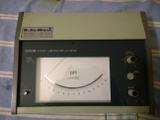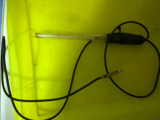MarcoP
Well-known member
Luckily today I've got a PH meter for free, it comes from a clinic and the owner (different one since the clinic originally opened) doesn't know much about it.
It turns on but I guess the electrode is gone, in fact put it in a glass of water and it didn't move at all.
Could someone give me some keywords so I could search for a replacement, and what type?
Or would it be possible to use a different socket at the back of the unit or modify one to use a BNC electrode (today easily available).




*Click on thumbnail for hi resolution image.
Got it for free, if I can make it work (even if it's a huge unit) great, otherwise nothing lost. For once I've got something for free I just hope in good news :lol:
Thanks in advance
It turns on but I guess the electrode is gone, in fact put it in a glass of water and it didn't move at all.
Could someone give me some keywords so I could search for a replacement, and what type?
Or would it be possible to use a different socket at the back of the unit or modify one to use a BNC electrode (today easily available).




*Click on thumbnail for hi resolution image.
Got it for free, if I can make it work (even if it's a huge unit) great, otherwise nothing lost. For once I've got something for free I just hope in good news :lol:
Thanks in advance






































